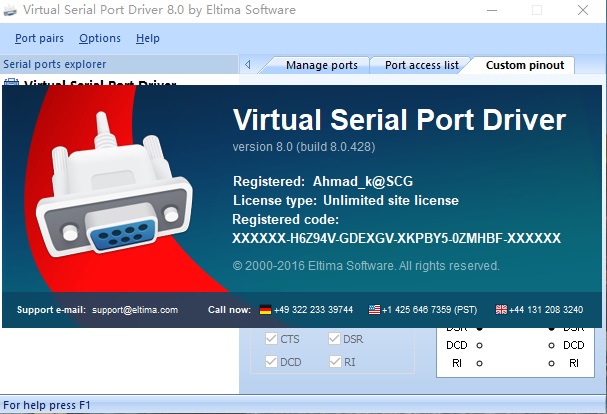
Then the second solution is to be realized. I thought about the first option, but I thought I didn't have this capability yet, so I gave up decisively and retreated to the second option.
Vspd exe install#
If we can find this driver and install it, then use the corresponding interface to call it, or it is feasible. In order to realize virtual COM, there must be corresponding drivers. Option II: VSPD installation package is an installation program.
Vspd exe serial#
Those who are interested can refer to the article " Developing Virtual Serial Port Driver ". Solution 1: Write a virtual COM driver yourself, and then implement it inside. When the virtual COM port can realize communication, I think our program is dependent on this VSPD installation package, then if we can not rely on it? There are two options:
Vspd exe software#
For details, please refer to this document chapter " Example of serial port programming with vspd software under win7 system ". Remember that VSPD's COM communication is paired, one for receiving data and one for sending data.Īfter having the virtual COM port, just write a DEMO for testing.
Vspd exe how to#
For details on how to use it, please refer to this article "How to use virtual serial port VSPD ". After the installation is complete, you can use the software interface to create the corresponding virtual COM port. So I downloaded a VSPD7.1 installation package.

My computer is WIN7_64, so I chose VSPD7. Searching on the Internet, there are mainly VSPM and VSPD, the former is stable before WIN7, and the latter is stable in WIN7. The communication method between our project and the machine is based on the COM port, so to make a virtual machine, the first problem to be solved is to create a virtual COM port.

Vspd exe drivers#
In the following example the device is assigned a new device container and is displayed as a separate physical device.Ī USB Type-C connector must be correctly described in ACPI in order to pass the USB Type-C ACPI Validation Hardware Lab Kit test.Įxample _UPC for a USB Type-C connector: Drivers Targus Group Int Port Devices Downloadįor more information about the ACPI 6.0 interface, see Advanced Configuration and Power Interface Specification Revision 6.0.When testing a development project recently, it is inconvenient to set up a physical machine every time, so I wondered if I could write a virtual machine to facilitate testing. PortConnectorType byte must be set to the appropriate USB connector type as specified in Section 9.13 of the ACPI 3.0 specification. To specify a port that is external (user visible) and can be connected to an external device, the _UPC.PortIsConnectable byte must be set to 0xFF and the _PLD.UserVisible bit must be set to 1. In the following example the device is grouped with the computer's device container. To specify a port that is internal (not user visible) and can be connected to an integrated device, the _UPC.PortIsConnectable byte must be set to 0xFF and the _PLD.UserVisible bit must be set to 0. The following examples show correctly formed ACPI Source Language (ASL) that demonstrates the use of the _UPC and _PLD objects to describe a USB port: Note It is an invalid configuration to define a port as not connectable but visible to the user. Port is an excess port that is not connected to a port plug terminal or an integrated device. Port is physically implemented by the USB host controller, but is not used. Port is directly hard-wired to an integrated device, such as a laptop webcam or an internal USB hub. Port is hidden or internal and user cannot freely connect and disconnect devices. Port is exposed on the face of a panel on the computer that is visible to the user. Port is visible and the user can freely connect and disconnect devices. Drivers Targus Group Int Port Devices List USB Port Status The following table shows how the values of the ACPI objects for a given port affect the value of the USB hub descriptor DeviceRemovable bit that Windows reports for the device. Using only the _UPC object might not set the device container grouping correctly or as expected.ĭevices that are attached to the port are removable from the hub if the DeviceRemovable bit is set. Although the ACPI 6.0 specification does not specifically prohibit the use of only the _UPC object, the use of both objects more precisely indicates the user's ability to connect devices to the port. If you use ACPI to specify the configuration of a USB port, you must define the USB port capabilities ( _UPC) and physical location description ( _PLD) objects. If the system requires ACPI BIOS changes to accurately reflect the USB port configuration, you should consider the user's ability to connect a device to the port when you configure the port.


 0 kommentar(er)
0 kommentar(er)
